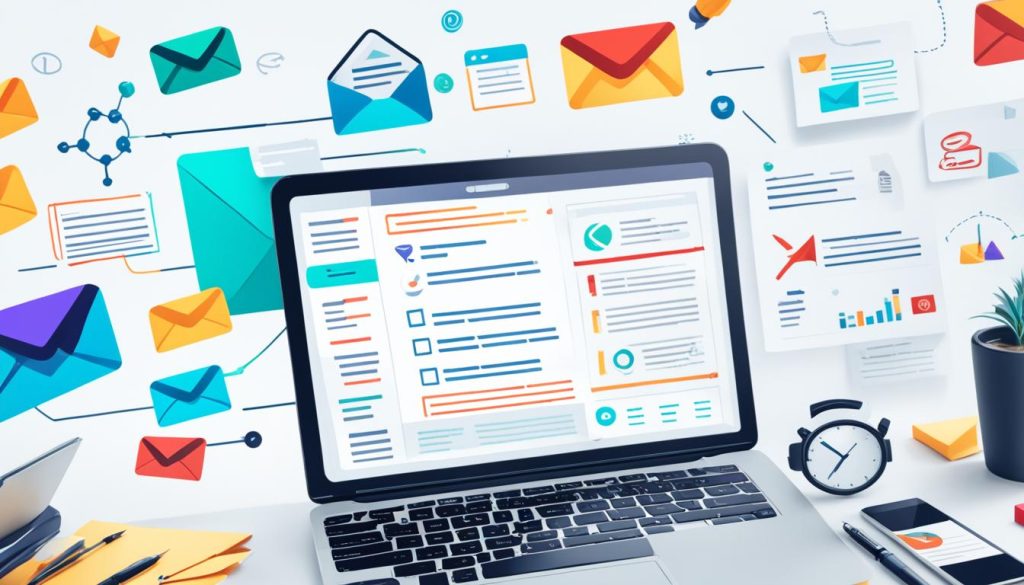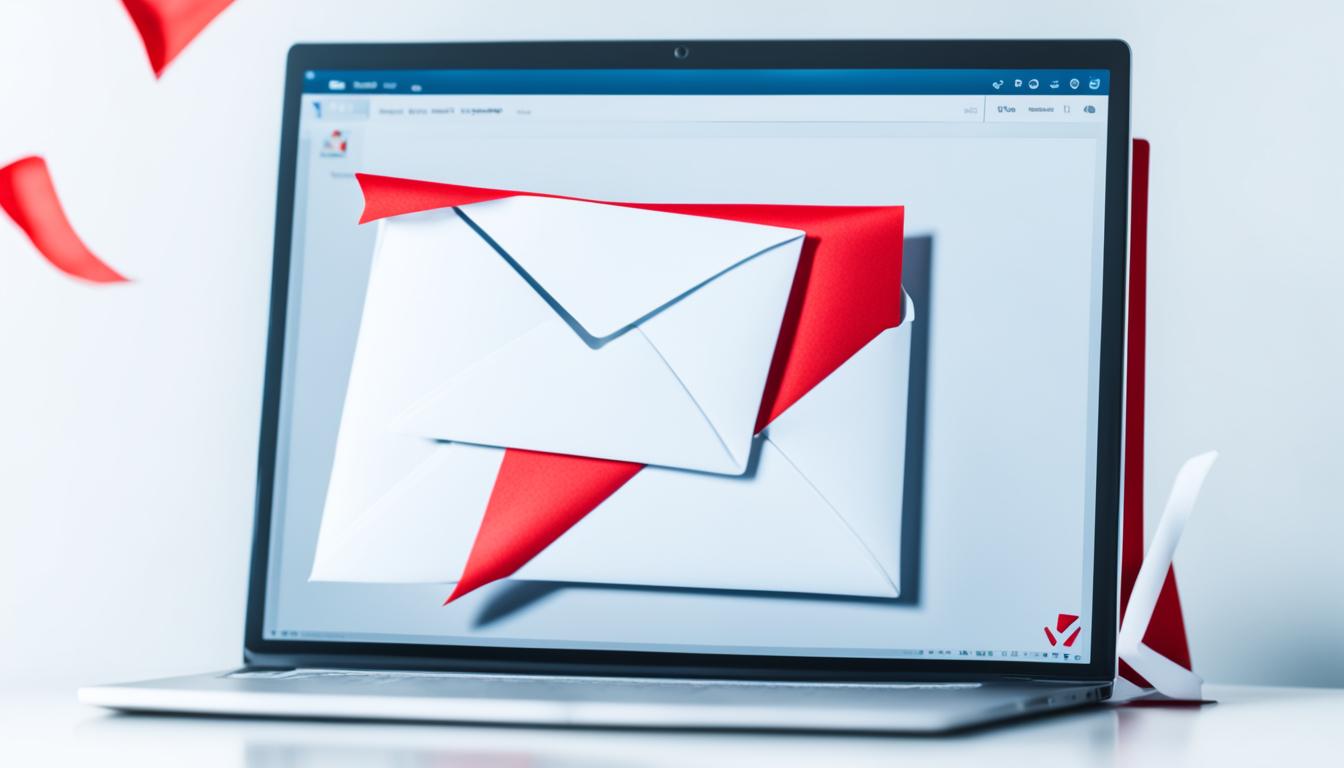Are you a blogger wanting to boost your content marketing? Ever thought about using email to get more traffic and engagement for your blog? You’re in the right spot.
Email marketing can bring back $42 for every $1 you spend. It’s a top choice for bloggers looking for an affordable way to market online. In this guide, you’ll learn how to use email marketing to grow your blog and reach your goals.
You’ll discover how to build a strong email list, create engaging campaigns, and automate your outreach. These are key skills for any blogger wanting to master email marketing. Get ready to see your blog’s performance soar and your audience grow.
What is Email Marketing?
Email marketing is a key digital strategy that sends messages to subscribers via email. It helps bloggers connect with their audience, increase brand awareness, and drive traffic to their site. This strategy also helps bloggers make money from their blog.
Email Marketing Definition and Key Concepts
Email marketing is about sending emails to people who want to hear from you. It’s all about building relationships and promoting products or services. The main aim is to get people to visit your website, engage with your content, and make purchases.
Benefits of Email Marketing for Bloggers
Email marketing has many perks for bloggers. It lets you:
- Build a direct way to talk to your audience
- Boost your brand’s visibility
- Send more people to your blog and share your content
- Turn subscribers into customers
- Use a marketing method that’s both affordable and easy to measure
With over 4 billion email users worldwide, email marketing connects bloggers with a huge, active audience. It also has a great return on investment (ROI) of $36 for every $1 spent. This makes it a smart way for bloggers to make money and expand their business.
Getting Started with Email Marketing for Bloggers
Starting with email marketing for bloggers means knowing who you’re talking to. First, make buyer personas to understand your ideal subscribers. This helps you send emails that really speak to them. Use your blog stats, social media, and customer info to get a clear picture of your audience.
Define Your Target Audience
Knowing who you’re sending emails to is key. By making buyer personas, you learn a lot about your ideal subscribers. Think about their age, where they live, what they like, and what problems they face.
Set Clear Goals and Benchmarks
Before you start sending emails, set clear goals. Think about what you want to achieve, like more subscribers, more website visits, more sales, or more engagement. Look up industry benchmarks for things like open rates and click-through rates. This helps you set realistic goals.
Keep an eye on how you’re doing and tweak your plan as needed. This way, you can hit your targets and get the results you want.
https://www.youtube.com/watch?v=MH00bCUcx2A
| Email Marketing Metric | Industry Average | Your Target |
|---|---|---|
| Open Rate | 18-22% | 25% |
| Click-Through Rate (CTR) | 2-3% | 5% |
| Conversion Rate | 1-2% | 3% |
Building an Email List
Growing your email list is key to a strong email marketing plan for bloggers. Use opt-in forms wisely on your site to get visitors to sign up. This way, they become part of your loyal audience.
Opt-in Forms and Signup Incentives
Put your opt-in forms where they get the most views, like the homepage, sidebar, and landing pages. Offer something great, like a free ebook or a special discount, to get people to give you their email. Keep testing and improving your opt-in forms to get more people to join your email list.
Here are some tips to grow your email list:
- Make your opt-in forms look good and easy to find
- Give people something valuable when they sign up, like a free guide
- Make sure your opt-in forms work well on mobile devices
- Share your opt-in forms on your website, social media, and other places
- Keep checking how well your opt-in form strategy is working and make it better
By focusing on building a great email list with smart opt-in forms and good signup incentives, you’re setting up for a successful email marketing plan. This plan will help you engage with your audience and increase conversions for your blog.
Types of Email Campaigns for Bloggers
As a blogger, you can use different email campaigns to connect with your readers and meet your marketing goals. These include welcome emails, newsletters, and promotional emails. Let’s look at some effective email campaign types for bloggers.
Welcome Emails
A warm welcome email is great when someone new joins your list. It’s a chance to introduce yourself and your blog’s mission. You can also invite them to check out your content.
Newsletters
Newsletters are key for bloggers. They let you stay in touch with your readers, share new posts, and offer valuable info. Make sure your newsletters are engaging to keep your readers interested.
Promotional Emails
Promotional emails are great for promoting new products or services. They can be a strong part of your email marketing campaign examples. Create messages that highlight the benefits and motivate your readers to act.
Cart Abandonment Emails
Cart abandonment emails are crucial if you sell products on your blog. These emails remind people about the items they left behind. They encourage them to finish their purchase.
Seasonal Campaigns
Seasonal and holiday-themed types of email campaigns for bloggers can be powerful. They help you stay relevant and offer timely deals to your audience.
Triggered Email Series
Automated email series can help you engage with your subscribers. They can be triggered by actions or behaviors. For instance, you could send a series of emails to welcome new subscribers, teach them about your products, and encourage a purchase.
By using these various email campaign types, you can build a strong email marketing campaign examples strategy. This strategy will connect with your audience and help you reach your blogging goals.
Crafting Effective Email Content
Making email content creation that grabs your audience’s attention is key to your email marketing success. Start with compelling subject lines that make people curious and want to open your emails. Adding email personalization, like the person’s name or interests, makes your emails stand out and stick in their minds.
Your email should be short, useful, and meet your audience’s needs. Try out different subject lines, tones, and to see what works best with your subscribers.
Writing Compelling Subject Lines
Subject line optimization is key to getting your audience to open your emails. Make your subject lines interesting, relevant, and clear about what’s in it for them. Try using emojis, asking questions, or highlighting a special deal to see what works best for your personalized email marketing strategy.
Personalizing Email Messages
Email personalization can greatly boost engagement and lead to better results. Use customer data like name, location, purchase history, and interests to make emails that feel made just for each person. Personalized emails can increase open rates by up to 26% and lead to a 760% jump in email revenue. Use personal touches, such as using their name, referencing past interactions, and suggesting products they might like.
Email marketing for bloggers
Email marketing is key for bloggers. It lets you connect directly with your audience. This builds a relationship that helps drive traffic to your blog, promote your content, and make money. By sending valuable emails, you become a trusted expert in your field. This helps turn leads into loyal customers or brand fans.
For email marketing for bloggers, having a strong blog email strategy is crucial. It should match your business goals and what your audience likes. Here are some important points to consider:
- Grow your email list: Use lead magnets, opt-in offers, and clear signup forms to get more people to join your list.
- Segment your audience: Break your list into smaller groups based on who they are or what they like. This makes your emails more personal.
- Create valuable email content: Share new blog posts, special content, industry tips, and other useful stuff your subscribers will enjoy.
- Automate your email campaigns: Use automation to send out messages, follow-up sequences, and personalized campaigns at the best time.
- Analyze and optimize: Check your email marketing stats often. Look at open rates, clicks, and conversions to see what works and what doesn’t. Then, make your strategy better.
Using email marketing as a key part of your blog’s growth helps you build a dedicated subscriber base. This leads to more traffic and more money for your business.

| Key Metrics for Email Marketing Success | Benchmark | Your Current Performance |
|---|---|---|
| Open Rate | 15-25% | 18% |
| Click-Through Rate (CTR) | 2-5% | 3.5% |
| Conversion Rate | 1-3% | 2% |
| Unsubscribe Rate | Less than 0.5% | 0.3% |
Optimizing Email Design and Layouts
In the world of email marketing, how your emails look and feel is key to grabbing attention and getting people to engage. Two important things to think about are mobile responsiveness and accessibility.
Mobile Responsiveness and Accessibility
More than 46% of emails are opened on mobile devices. So, it’s vital that your emails work well on all screens and devices. Mobile-responsive email makes sure your content looks good and works well, no matter the device. This means clear fonts, easy navigation, and a design that’s a joy to use.
Accessibility is also key in email design. By making your emails accessible, you make sure everyone can read and use them. This means using high-contrast colors, adding text for images, and keeping the design simple and clear.
| Design Element | Mobile-Responsive Considerations | Accessibility Considerations |
|---|---|---|
| Fonts | Use legible, easy-to-read fonts that scale well on mobile devices. | Ensure font size and color contrast meet accessibility guidelines. |
| Images and Graphics | Optimize image size and resolution for mobile, and use responsive design techniques. | Provide alternative text descriptions for all images and graphics. |
| Layout and Structure | Employ a clean, uncluttered layout that is easy to navigate on smaller screens. | Use a logical, hierarchical structure with clear headings and spacing. |
| Calls-to-Action | Make CTAs prominent and easy to tap on mobile devices. | Ensure CTAs are accessible for users with motor impairments. |
By focusing on making your emails work well on mobile and be accessible to everyone, you can make sure they’re effective and reach all your subscribers. This approach to design helps you build stronger connections and get better results for your brand.
Email Automation and Workflows
As a blogger, using email marketing automation and automated email workflows can change the game for your business. These tools help you make your email marketing better. They send the right messages to the right people at the right time without needing you to do it all by hand.
Email automation lets you set up automated email sequences. You can have welcome series, cart abandonment campaigns, and lead nurturing workflows. These sequences make sure your audience gets a consistent, personalized experience. They keep them interested and help them move through your sales funnel smoothly.
- Welcome series: Introduce new subscribers to your brand and content with a series of automated emails that build trust and rapport.
- Cart abandonment: Automatically follow up with subscribers who have abandoned their shopping carts, encouraging them to complete their purchases.
- Lead nurturing: Nurture your leads with a sequence of educational and promotional emails, guiding them towards conversion.
Using email automation saves you time. It makes your messages more relevant and timely. This leads to better engagement and more conversions from your email marketing.

To start with email automation and workflows, link your email marketing platform with your blog or website. This lets you easily get subscriber info, start automated sequences, and see how your campaigns are doing.
Segmenting Your Email List
Effective email marketing for bloggers means segmenting your email list well. By putting your subscribers into groups, you can send content that really speaks to them. Think about using demographic segmentation and interest-based segmentation.
Demographic Segmentation
Begin by sorting your list by things like where they live, their age, gender, job, and how much they make. This way, you can make campaigns that really talk to each group’s needs and interests. For instance, you might send different stuff to people in New York versus those in Los Angeles. Or, you could send different messages to young professionals versus retirees.
Interest-Based Segmentation
You can also sort your list by what your subscribers like and how they interact with your emails. Look at what they prefer to read, what they buy, and how they react to your emails. This helps you send updates, product tips, and deals that are just right for them.
Getting good at email list segmentation can really boost your email marketing. It helps you connect better with your audience as a blogger.
Email Marketing Best Practices
As a blogger, it’s key to keep up with the latest email marketing best practices. Keeping your email list clean, making it mobile-friendly, and personalizing your messages are important steps. Always test and improve your methods, following rules like CAN-SPAM and GDPR, to keep your subscribers interested and your campaigns successful.
One top email marketing tip is to check your performance often. Look at open rates, click-through rates, and unsubscribe rates. This helps you make smart choices and keep your emails relevant and useful to your readers.
- Keep your email list clean by checking and removing inactive or uninterested subscribers.
- Make sure your emails look good on mobile devices since many people check emails on their phones.
- Personalize your emails by using subscribers’ names and focusing on their interests and actions.
- Try out different subject lines, email designs, and calls-to-action to see what works best.
- Keep up with email marketing laws and follow them, like CAN-SPAM and GDPR.
By using these email marketing best practices, you can make your email campaigns better. Improve your strategies with data and feedback to stay ahead and give great value to your readers.

Measuring and Analyzing Email Performance
It’s key to track and analyze your email marketing campaigns. This helps you see what works and where you can get better. By watching important email metrics, you learn about your subscribers’ actions. You can then improve your content and strategy for better results.
Key Email Marketing Metrics to Track
For bloggers, some top email marketing metrics to watch include:
- Open Rate: The percentage of subscribers who open your emails.
- Click-Through Rate (CTR): The percentage of subscribers who click on links in your emails.
- Conversion Rate: The percentage of subscribers who take a desired action, like buying something or signing up for a service.
- Bounce Rate: The percentage of emails that can’t be delivered, often because of wrong email addresses or other issues.
- Unsubscribe Rate: The percentage of subscribers who choose to leave your email list.
Checking these email marketing analytics often helps you see what your audience likes. It also shows where you might need to tweak your email content, design, or strategy.
Using data to guide you, you can keep making your email campaigns better. This ensures they keep bringing a good return on investment (ROI) for your blog.
Integrating Email with Other Marketing Channels
To make your marketing work better, it’s key to link your email marketing with other marketing ways. This omnichannel marketing strategy helps you create a strong brand experience. It also makes your brand more visible and boosts your marketing results.
Here are some easy ways to link email marketing with other channels:
- Boost your YouTube videos with email. Share your newest videos through email and ask viewers to subscribe to your channel.
- Use email with LinkedIn outreach and cold calls to find new leads. Connect with potential customers on LinkedIn using your email list and follow up with personalized cold calls.
- Make the most of email signatures. Add a call-to-action or a link to your latest deal in your email signature. This makes it easy for people to interact with your brand.
- Link email with paid ads on various platforms. Retarget your email subscribers with ads on Google, Facebook, and Instagram to keep them thinking of you.
- Boost your social media posts with email. Share your latest blog posts, deals, or updates on both email and social media to spread your message wider.
| Marketing Channel | Integration Tactic | Potential Benefits |
|---|---|---|
| YouTube | Promote video content through email | Increased video views and subscriber growth |
| Combine email outreach with cold calls | Improved lead generation and conversion rates | |
| Email Signatures | Include calls-to-action and offers | Increased brand awareness and engagement |
| Paid Advertising | Retarget email subscribers with ads | Enhanced customer retention and loyalty |
| Social Media | Align email and social media content | Amplified message reach and engagement |
By linking email marketing with your other marketing efforts, you can offer a smooth and tailored customer experience. This leads to better results for your business.

Email Regulations and Compliance
If you’re into email marketing, you must know the rules. The CAN-SPAM Act and the GDPR are key. They tell you what to do and what not to do with emails.
CAN-SPAM and GDPR Requirements
The CAN-SPAM Act sets rules for commercial emails. It says you must give people a way to opt out, be clear about who sent the email, and not trick them with false subject lines. Breaking these rules can lead to big fines and legal trouble.
The GDPR is all about keeping EU residents’ personal data safe. You need to get clear consent from people, tell them how you’ll use their data, and let them stop their consent anytime.
Following these email marketing regulations keeps your brand safe and builds trust with your readers. It makes your email marketing better and keeps you in line with the latest digital rules.
| Regulation | Key Requirements | Penalties for Noncompliance |
|---|---|---|
| CAN-SPAM Act |
|
Fines up to $43,792 per email |
| GDPR |
|
Fines up to €20 million or 4% of global annual revenue |
Email Marketing Tools and Resources
As a blogger, using the right email marketing tools and resources can really help your campaigns. There are many options available, from powerful email service providers (ESPs) to useful industry publications. These tools and resources can make your work easier and give you important insights.
When looking at email marketing tools, think about getting an ESP with lots of features. Look for ones that have list management, campaign automation, real-time analytics, and A/B testing. These tools can help you make your emails look great, sort your audience, and track important metrics to improve your campaigns.
But it’s not just about the tools. Keeping up with the latest trends and best practices in email marketing is key. Check out email marketing blogs, industry publications, and online communities. Here, you can learn from experts, find new strategies, and stay on top of the latest news.
Top Email Marketing Tools for Bloggers
- Mailchimp: Offers a user-friendly interface, pre-designed templates, and a free plan for small businesses.
- ConvertKit: Specializes in creating custom opt-in forms and automating email sequences for bloggers.
- Constant Contact: Provides a range of features, including email campaigns, social media integration, and list management.
- ActiveCampaign: Combines email marketing with customer relationship management (CRM) and marketing automation.
Essential Email Marketing Resources for Bloggers
- Email Marketing for Bloggers by Neil Patel: A comprehensive guide on leveraging email to grow your blog audience.
- The Email Marketing Podcast: Informative episodes on email strategy, trends, and best practices.
- The HubSpot Email Marketing Blog: Offers valuable insights and tips from industry experts.
- The Email Experience Council: A professional association that provides resources, research, and events for email marketers.
| Email Marketing Tool | Key Features | Pricing |
|---|---|---|
| Mailchimp |
|
Free plan available, paid plans start at $9.99/month |
| ConvertKit |
|
Paid plans start at $29/month |
| Constant Contact |
|
Paid plans start at $9.99/month |

Monetizing Your Email List as a Blogger
Your email list is a key asset for making money as a blogger. By looking into different ways to make, you can turn your list into a steady source of income. This helps grow and keep your blogging business going.
One good way is to share affiliate products with your email followers. Pick products that fit well with your blog and are of high quality. This way, you can make money and help your readers at the same time. You could also offer special content, like detailed guides or courses, for a fee.
Another idea is to sell your own digital or physical products to your list. This might be e-books, online classes, or items related to your blog’s topic. By being trustworthy and giving great value, you can make money from your email list. This supports the ongoing success of your blog.

